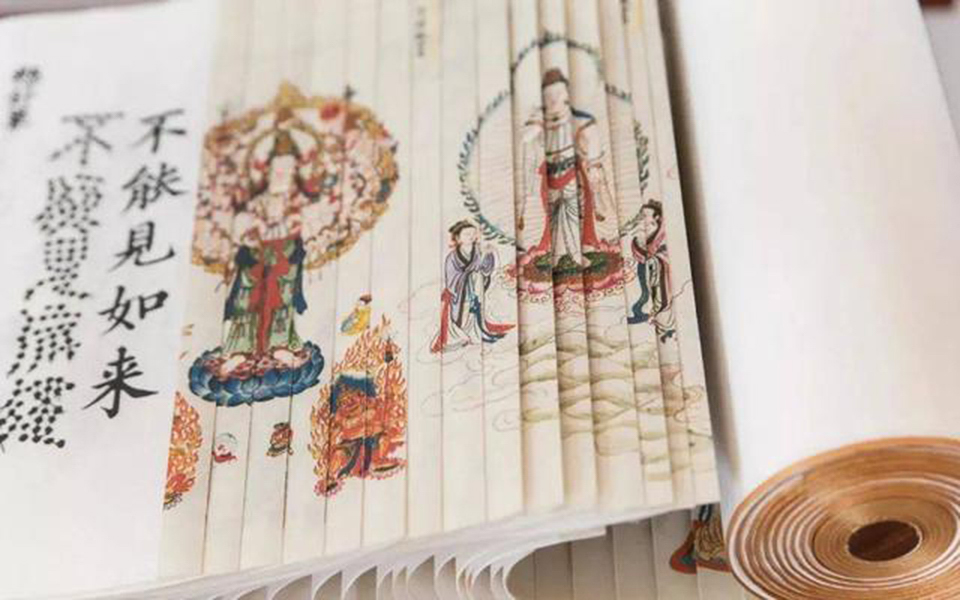
“Zhang Xiaodong made two predictions about the future of books: electronic books and exquisitely crafted physical books for collecting. He decided to pursue the latter.”
Yunmeng Jia is impressed with the vision and dedication of Zhang Xiaodong, the sole inheritor of a unique bookbinding craft and a Chinese intangible cultural heritage.
“Dragon Scale Binding,” also known as “Whirlwind Binding,” is a form of ancient Chinese bookbinding, dating back to the mid-Tang Dynasty. Its format involves using a long piece of paper as the base. The first page is fully pasted at the beginning of the scroll. Then starting from the second page, each page is bound and pasted to the previous one, creating a layered effect resembling dragon scales. This unique format makes it easy to flip through and protects the pages. When reading, the long tail of the scroll gracefully curls up, giving the impression of a real dragon with scales swimming leisurely. The densely written text appears and disappears as the pages are flipped—yes, it’s also a type of book.
Among the vast collection of books, only one physical Dragon Scale Binding remains, currently housed in the Forbidden City’s Palace Museum, titled “Kan Miu Bu Que Qie Yun.” It is so precious that even Puyi, the last Emperor of China, carried it with him when he fled in the late Qing Dynasty. Fortunately, someone persevered and spent over a decade “searching” through historical traces, ultimately bringing this dusty craft back into the light. This individual is Zhang Xiaodong, the inheritor of Dragon Scale Binding craftsmanship. Zhang Xiaodong who entered the book industry halfway, undaunted by the declining prospects, immersed himself in painstaking research, which eventually bore fruit. “If an industry tells you it’s a dead-end, but you love it so much, then you should find a way.”
Zhang Xiaodong, a graduate in industrial design, has had a deep affection for books since childhood. While staying at home, he would often browse through the books left by his parents in the family library whenever he missed them. From that time onwards, he felt soothed and healed by the elegant arrangement and combination of books. After graduating from college, he coincidentally entered the Silk Screen Printing Technology Association in Beijing, where he came into contact with many experts and scholars in the book industry, thus entering the world of books. At that time, Zhang Xiaodong made two predictions about the future of books: electronic books and exquisitely crafted physical books for collecting. He decided to pursue the latter.
When reading as a whole, it gave a sense of “a dragon swimming within the book, and the book dwelling within the dragon.”
In 2008, at the age of 27, Zhang Xiaodong first encountered a description of Dragon Scale Binding in “Guji Banben Jianding Congtan.” Despite its brevity, it formed a vibrant and even science-fiction-like image of books in his mind,. Dragon Scale Binding is a bookbinding format that transitioned from scrolls to bound pages in ancient books. It was a skill kept within the palace and rarely seen in the common world. It resembled a scroll, with a long piece of paper serving as the base. The first page was entirely pasted onto the base, and from the right edge of the second page with no text, a paper strip was attached to the base. The remaining pages were successively adhered under the previous one. This arrangement allowed the pages to stack like dragon scales, making it convenient for reading and protecting the contents. Zhang Bangji of the Song Dynasty described it in Mozhuang Manlu as “pages flipping one by one, unrolling to the end, yet still forming a single scroll.” When reading as a whole, it gave a sense of “a dragon swimming within the book, and the book dwelling within the dragon.”
“It’s hard to imagine that this image is something from a thousand years ago.” Zhang Xiaodong was deeply fascinated by Dragon Scale Binding. However, this skill had a very limited existence and had been lost for a long time. No one knew how to accurately restore this bookbinding form. Zhang Xiaodong also lacked experience and knowledge of bookmaking. All he had was unwavering belief, perseverance, and a desire to carve out a niche. Despite the declining physical book industry, Zhang Xiaodong was determined to research and replicate Dragon Scale Binding. However, it was a meticulous and laborious task, a never-ending marathon: measuring, cutting, folding, ironing, pasting… Each step had to be precise with no room for error.
He tirelessly read various ancient texts and made repeated attempts to create sample books. He sought guidance from experts in the field, experts from the Palace Museum, scholars in the field of ancient painting restoration, and printing industry veterans. Over the years, the discarded papers used for research and failed attempts filled an entire room. Gradually, Zhang Xiaodong accumulated knowledge about Dragon Scale Binding and gained experience. The process of creating Dragon Scale Binding is not overly complex, and the tools required are quite simple: a knife, a ruler, a pen, an iron, and stacks of paper.
The most significant challenge was controlling the error rate at the page edges. The saying “a tiny difference in the beginning leads to a huge difference in the end” aptly describes this. Even a 0.1mm error on each page edge, when accumulated over hundreds of pages, would result in a significant deviation, a major mistake. This tedious, repetitive, and meticulous mechanical work caused many who attempted to learn Dragon Scale Binding to give up halfway. Zhang Xiaodong, however, persisted. After two and a half years of hard work, Zhang Xiaodong finally completed his first Dragon Scale Binding work, “The Thirty-Two Seals Diamond Sutra,” in 2010, which won the Gold Award at the Chinese Printing Awards.
This work was created on top-quality Jinxian Xuan paper from Jing County, Anhui Province. It had 217 pages, with a rolled-up scroll diameter of 12 centimeters and an extended length of about 8 meters, resembling a winding dragon—this was a very Zen expression, and reading the scriptures within gave a feeling of being immersed in the world of the book.
Hard work pays off, and over the past decade, Zhang Xiaodong has obtained more than 20 national invention patents and has been officially recognized as the sole inheritor of Dragon Scale Binding as an intangible cultural heritage. He has been invited to showcase his works at international events such as the Venice Art Biennale, Hong Kong Art Week, and the World Handmade Book Exhibition, astonishing people from around the world. He said, “If an industry tells you it’s a dead-end, but you love it so much, then you should find a way to keep it alive—creating the most beautiful books in China is my wish.” “The reading experience from a thousand years ago does not feel outdated at all; instead, it feels like being immersed in a 3D movie.” Subsequently, Zhang Xiaodong and his team spent four and a half years creating the hundred-meter-long “Qing · Sun Wen’s Illustrated Version of the Dream of the Red Chamber,” which made it to the top of the “Most Beautiful Books Exhibition” rankings.
This work combines the original text, the Cheng Jia version, and Sun Wen’s illustrations, with a total of eight boxes. Each box is approximately 62 centimeters long, 38 centimeters wide, and about 15 centimeters high. When all eight boxes are stacked together, they reach a height of 124 centimeters and weigh 200 kilograms. It requires 3,000 square meters of space to display them all.
In traditional Dragon Scale Binding, there are no patterns at the page edges. Zhang Xiaodong, considering the reading preferences of modern readers, made improvements: he meticulously designed illustrations on the page edges, and when these pages are laid flat, they form a complete picture.
Reading a Dragon Scale Binding book is a highly ceremonial act. While not as elaborate as ancient rituals involving bathing and incense, it should be approached with a sense of reverence and appreciation: wearing gloves, using a book opener, gently turning each page, and slowly immersing oneself in the world of the book.





